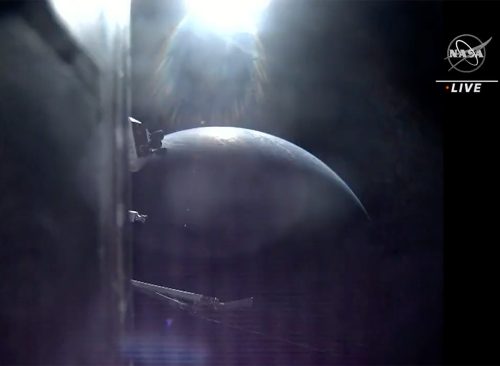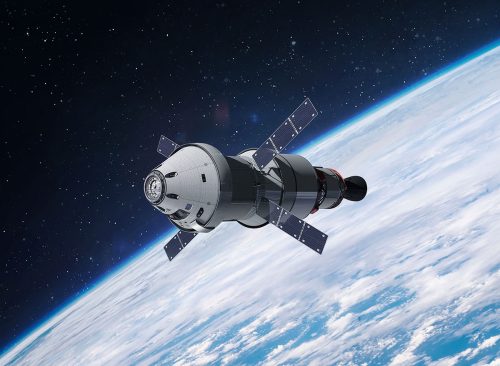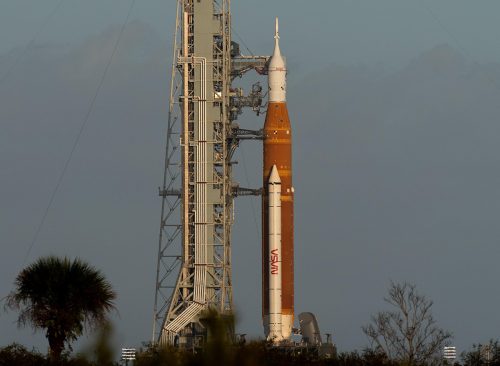NASA’s Spacecraft Captures Stunning Footage of First View of Earth from Orion
"Awe-inspiring."

The launch of NASA’s much-heralded Artemis I rocket went off without a hitch on Wednesday morning, and it’s already sending back souvenirs. NASA has released a video showing Earth from the Orion capsule during liftoff and as the craft climbed higher and higher into space. In the 24-second clip, Earth slowly becomes smaller and smaller as the next-generation rocket accelerates into the stratosphere.
“We rise together, back to the moon and beyond,” said NASA’s official commentator as Artemis took off. Read on to find out more about the Artemis/Orion mission and how social media reacted to the stunning video.

The unmanned Artemis I began a 26-day mission about 2 a.m. on Wednesday when it blasted off from Kennedy Space Center in Cape Canaveral, Florida, 50 years after the last manned mission to the moon. The Space Launch System (SLS) rocket has been in development for decades. NASA calls it “the most powerful rocket in the world.” At its tip, Artemis I contains a gumdrop-shaped capsule called Orion, which is intended to be the crew compartment in future manned missions.
It’s from Orion that the first video was broadcast. Artemis has two major tasks: Launching 10 miniature satellites, called CubeSats, which will assess conditions on the moon, and testing a heat shield that is intended to protect the craft from re-entry into the Earth’s atmosphere. Keep reading to learn more and see the video.

“As @NASA_Orion begins the #Artemis I mission to the Moon, the spacecraft captured these stunning views of our home planet,” NASA tweeted on Orion’s official Twitter account. It has been updated regularly since launch with information and images from space. The short clip shows Earth receding into the distance as the rocket ascends. Twitter commenters called the imagery “amazing” and “awe-inspiring.”
As @NASA_Orion begins the #Artemis I mission to the Moon, the spacecraft captured these stunning views of our home planet. pic.twitter.com/Pzk3PDt7sd
— NASA Artemis (@NASAArtemis) November 16, 2022

Artemis is intended to test the SLS rocket and the Orion capsule before missions begin with humans aboard. The craft is carrying a set of mannequins that represent astronauts, outfitted with multiple sensors that will report various flight conditions and gauge radiation levels. Artemis is slated to head to the moon, remain in its orbit for a few weeks, then return to Earth by splashing down in the Pacific Ocean on Dec. 11.
If the mission is successful, Artemis II and Artemis III missions are scheduled for 2024 and 2025, respectively. Artemis II will launch four astronauts in the Orion spacecraft on an expedition around the moon. In 2025, Artemis III will include the first woman and the first person of color to land on the moon—the first time humans have walked on the moon since 1972.

The U.S. space program made six Apollo missions to the moon via Saturn V rockets. The last was in 1972. After that, NASA concentrated on the exploration of low-earth orbit via the Space Shuttle and the International Space Station. For future missions to the moon, NASA determined a more advanced craft was necessary.
Artemis has been developed for more than a decade, and there have been complaints that the program is behind schedule and over budget. This year, NASA Inspector General Paul Martin said the agency is likely to spend $93 billion on the Artemis program from 2012 to 2025. Each Artemis launch is expected to cost about $4.1 billion.
RELATED: The 10 Most “OMG” Science Discoveries of 2022

NASA has revived missions to the moon with eyes on another target: Exploration of Mars. President Obama set a goal of landing humans on Mars by 2033, and the agency is proceeding along that timeline. In a press conference this month, NASA astronaut Randy Bresnik talked about how lunar exploration is preparation for a Mars landing. When you go camping on Earth for the first time, you wouldn’t use new gear and shoes that haven’t been broken in, he said. Mars isn’t the place to test out new gear for the first time, either. “We’re gonna go to some local places a little closer first,” said Bresnik. “Then you can come back home if your shoelaces break or something like that.”














